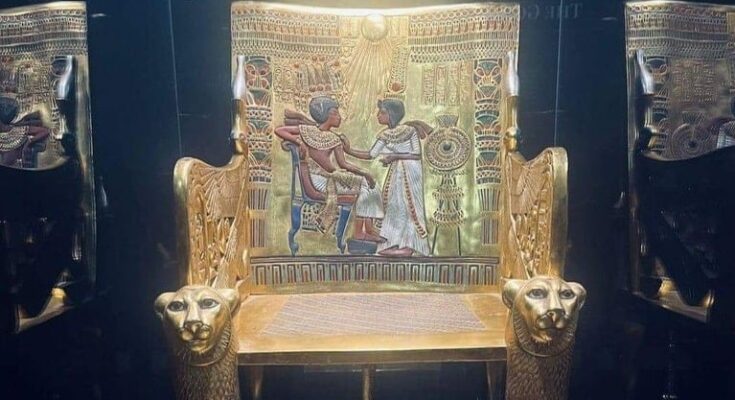
The throne of King Tutankhamun of Egypt covered in gold is one of the most striking artifacts ever discovered and is displayed at the Egyptian Museum in Cairo.
While its name suggests it’s solid gold, the throne is actually wood covered in pure gold leaf. This technique, along with inlays of colored glass and semi-precious stones, makes it a luxurious and intricately decorated piece of furniture.
The throne, which also had partially silver parts, was decorated with semi-precious stones, glazed ceramics and colored glass. The feet of the throne, which was approximately 1 meter tall and wrapped in linen, were carved to resemble lion’s feet.
An exemplary scene from Tutankhamun’s life is seen on the front of the throne: Under the rays of the Aten, the young pharaoh is represented sitting in a comfortable position, while his wife Ankhesenamun is rubbing his shoulders with perfume.
The pharaoh has a crown and a thick necklace around his neck, and the queen has a beautiful wreath on her head. A gold bracelet is seen on both feet as a symbol of the engagement.
Despite being over 3,000 years old, the throne’s colors remain vibrant, a testament to the skill of the ancient Egyptian craftspeople.

Discovery of the throne covered in gold
It was discovered by British archaeologist Howard Carter, along with the rest of the pharaoh’s tomb in 1922. For years, archaeologists had been searching for the tomb of Tutankhamun, with limited success. Finally, after years of funded excavations, Carter found a hidden entrance in the Valley of the Kings.
The tomb itself had multiple chambers. The golden throne was found in the antechamber, beneath a hippopotamus funerary bed. This suggests it may have been a practical piece of furniture used during Tutankhamun’s life, rather than solely a funerary object.
The discovery of the tomb and its treasures, including the golden throne, captured the world’s imagination and remains one of the most significant archaeological finds in history.
Tutankhamun died when he was 19
Tutankhamun, also often called King Tut, was an ancient Egyptian pharaoh who ruled from around 1332 to 1323 BC, during the 18th dynasty. He became pharaoh very young, between the ages of eight and nine. Because of this, his reign was guided by advisors until his death around the age of 19.

Recently, an international team of scientists reconstructed his face using a digital model of his mummified skull.
Tutankhamun’s most significant actions during his reign were reversing the societal changes enacted by his predecessor, Akhenaten, during the Amarna Period: Tutankhamun restored the traditional polytheistic form of ancient Egyptian religion, undoing the religious shift known as Atenism, and moved the royal court away from Akhenaten’s capital, Amarna.
Tutankhamun was one of the few kings worshipped as a deity during his lifetime; this was usually done posthumously for most pharaohs.
In popular culture, he is known for the vastly opulent wealth found during the 1922 discovery of his tomb, KV62, the only such tomb to date to have been found in near-intact condition.
Related: Pharaoh Tutankhamun’s Burial Chamber Could Contain Door to Nefertiti’s Tomb



